The adoption of liquid staking in the Cosmos ecosystem remains low, despite its potential benefits and the overall popularity of liquid staking in the other ecosystem.
The success of liquid staking protocols depends on factors including blockchain security, staking reward rates, and a thriving DeFi ecosystem, all of which can vary significantly across different blockchains.
While liquid staking has flourished on Ethereum thanks to its robust DeFi ecosystem, it has faced challenges in the Cosmos ecosystem. These challenges include a smaller native token supply, a lack of compelling DeFi use cases, and security concerns.
Drop Protocol, built on the Neutron network, aims to overcome these challenges and drive liquid staking adoption in Cosmos. Its strengths include an experienced team, Neutron's infrastructure and DeFi ecosystem, and an incentive structure designed to align the interests of all participants.
2.0% – That's the market share of liquid staking tokens in Cosmos Hub, out of total staked $ATOM. Although 62.4% of the total circulating supply is staked, the adoption of liquid staking remains remarkably low. Looking into other ecosystem, Celestia’s TIA has 3.56% of its staked token in a liquid staking protocol, and Osmosis has 6.28%.
Despite Cosmos being a hub for innovative staking experiments like ICS (Interchain Security), PoL (Proof of Liquidity) by Berachain, and deflationary tokenomics by Injective, liquid staking adoption remains low.
In Cosmos, liquid staking has evolved over time, from having successful projects like Lido on Terra, which once had around $10 billion in TVL to being integrated at the network level as a module named LSM (Liquid Staking Module). Liquid staking makes PoS blockchains more capital-efficient by allowing the use of locked tokens, yet it hasn’t been widely adopted in the Cosmos ecosystem.
Current efforts in the Cosmos ecosystem fall short. Many liquid staking projects have low TVL and only support specific tokens within the Cosmos appchain. However, the liquid staking landscape could expand with the launch of Drop Protocol on Neutron, the first member of the Lido Alliance. This article examines recent developments in staking operations, the state of liquid staking in Cosmos, and Drop Protocol.
As liquid staking gone through major technical developments over the past, there are still large market opportunities since the adoption is quite low. There are multiple projects building liquid staking protocol. The solution range from being a separate appchain, to a dapp in a specific blockchain.
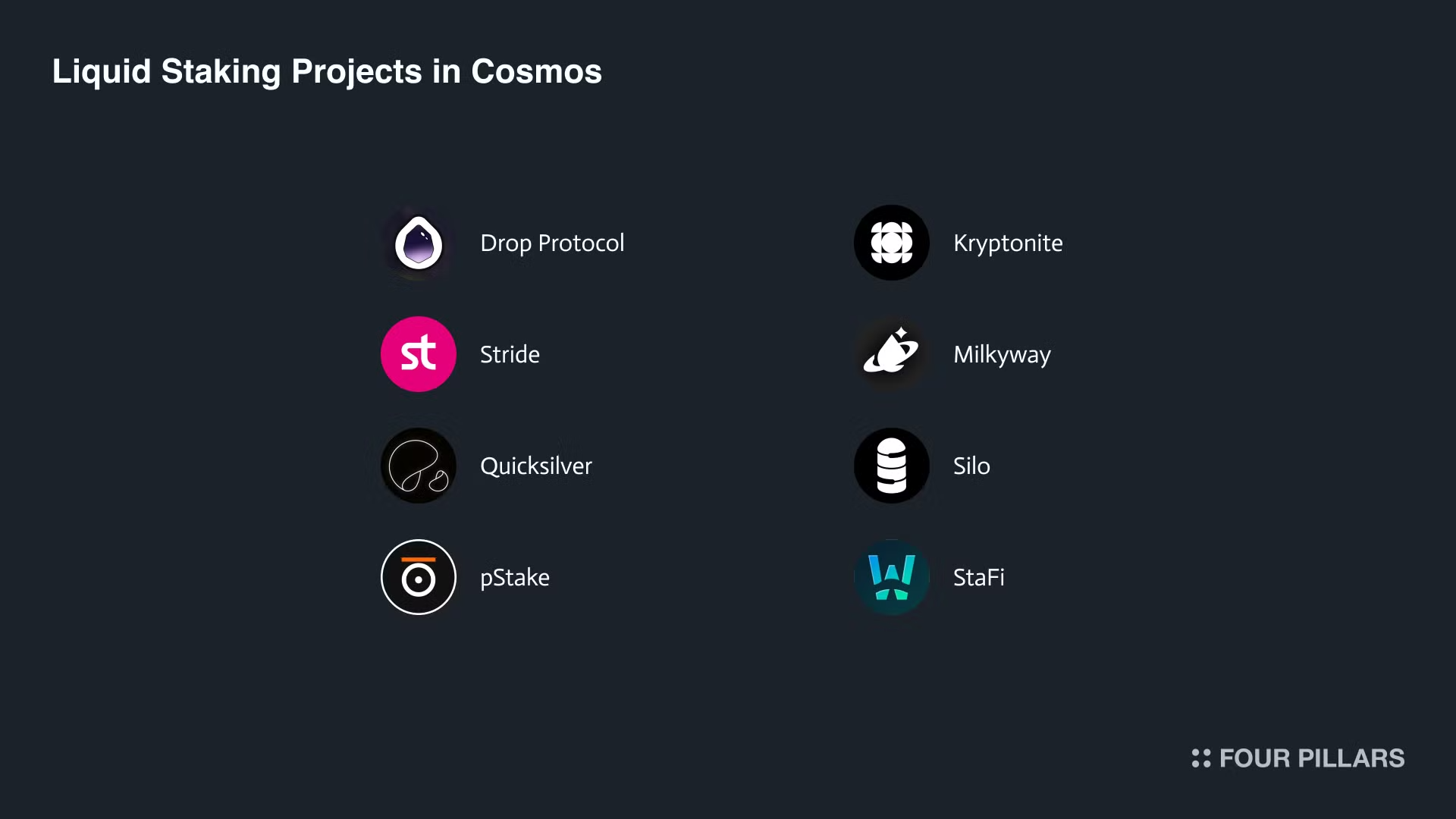
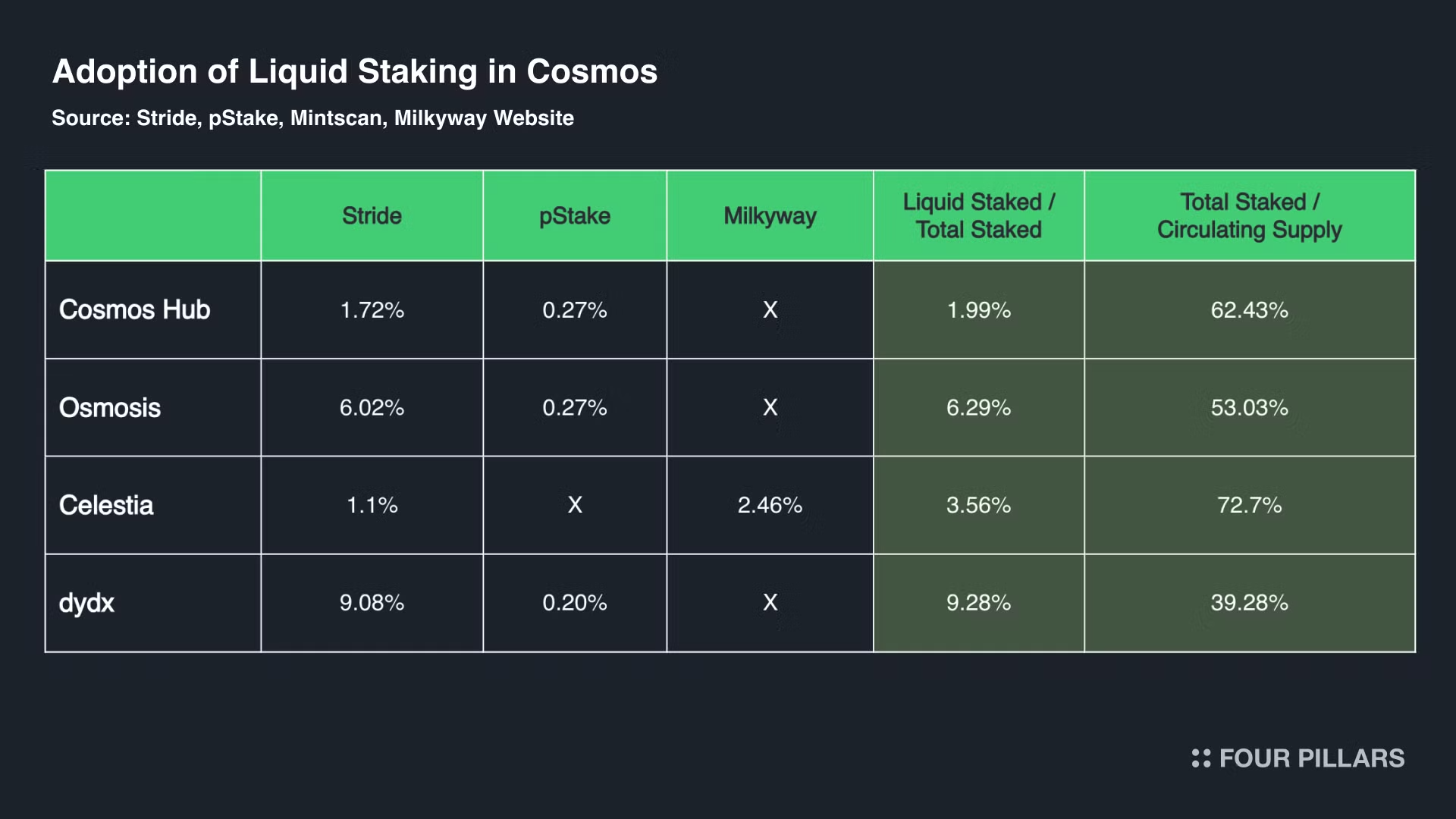
Source: Stride Stats, Mintscan Asset Page, pStake Dashboard, Milkyway website
The table provides a snapshot of the adoption of liquid staking within the Cosmos ecosystem. It shows the participation of various chains and the market share captured by different liquid staking providers, namely Stride, pStake, Quicksilver, and Milkyway.
The overall adoption of liquid staking in the Cosmos ecosystem is relatively low. The average liquid staking percentage across the listed chains is only 2%. This indicates that a significant portion of the token supply in these chains is not being utilized for liquid staking. For instance, the Cosmos Hub, with a total market cap of $2.02 billion, has $1.26 billion staked, which is around 62.4%. However, out of total staked amount, it only has 2% of its tokens staked through liquid staking. Similarly, Osmosis, Celestia, and dydx have liquid staking percentages of 6.28%, 3.56%, and 9.28%, respectively. Which is quite low compared to other ecosystem.
Although Stride currently stands out as the dominant liquid staking provider in the Cosmos ecosystem, its total market penetration remains a fraction of the overall market. Stride's liquid staking percentages for various chains are as follows: Cosmos Hub at 1.7%, Osmosis at 6.02%, Celestia at 1.1%, and dYdX at 9.08%. The rate is notably high for dYdX due to a recent proposal that passed, allowing the liquid staking of 20M DYDX from the community treasury to Stride. This accounts for 86% of the tokens liquid staked by Stride in dydx.
The market for liquid staking is still in its early stages, offering significant potential for growth and wider adoption. The adoption rate is very low compared to other ecosystems, so you might want to aim for the numbers in other ecosystems. In the following sections, let’s look into the factors that go into making liquidity staking successful
Liquid staking lets users stake their crypto assets while keeping them accessible by receiving a token that represents the staked assets. This token can be used in various DeFi dapps, allowing users to trade, lend, or borrow against their staked assets without unstaking them. This solves the problem of traditional staking, where assets are locked for a certain period. Liquid staking makes staking more attractive by reducing opportunity costs and enhancing DeFi ecosystem liquidity.
The success of liquid staking across different blockchains is influenced by several key factors. Some of the key success factors include
The blockchain itself should be secure: The security of the underlying blockchain are crucial, as they directly impact the stability and reliability of the staking process. Blockchains like Ethereum, which have transitioned to a PoS consensus mechanism, have experienced significant growth in liquid staking due to their robust security and large user base. As unstaking process usually takes long time, if the users don’t have faith in the security of the blockchain, it will be difficult to attract the users to stake. As seen from the recent Stride event where users couldn’t redeem their tokens due to do the software upgrade of the chain, vulnerable upgrade and monitoring system can be a huge risk for users to liquid stake.
Staking Reward Rate and DeFi Ecosystem: The staking reward rates offered by the blockchain play a vital role in attracting participants, as higher rewards can incentivize more users to stake their assets. Additionally, the demand and use of liquid staked tokens in the DeFi ecosystem are crucial. If DeFi protocols provide higher yields, users may prefer those over staking. The ideal scenario for users will be liquid staking tokens and utilizing tokens in DeFi.
Risk of slashing should be low: Slashing, where staked assets are lost due to validator errors, is a key concern. Liquid staking platforms must also ensure secure asset management to build user trust. Minimizing slashing risk with strong security and strict validator standards is crucial for reliability and adoption.
Only a few PoS blockchains have widely adopted liquid staking. Ethereum is the leader with $33 Billion in TVL Solana comes next with $4.4 Billion, where around 6.01% of its staked SOL is in liquid staking tokens, compared to Ethereum's 11.06% of staked ETH. On the other hand, Cosmos Hub has $23.53 million in liquid staking, representing about 2% of its staked value. Next, let’s look into how Ethereum could develop an ecosystem for liquid staking protocols.

Ethereum's transition to PoS and the subsequent implementation of the Shanghai/Capella upgrade, which allowed for the withdrawal of staked funds, significantly boosted confidence in liquid staking.
With over $33 billion in TVL in liquid staking protocols, major players in this space include Lido, Binance, Rocket Pool, and Mantle which together hold around 90% of the market share. Lido alone has a substantial portion, with $27.06 Billion worth of ETH staked through its platform, representing a 74% market share. So what were the key factors that made liquids staking protocols succeed in Ethereum?
2.1.1 Robust LSTfi Ecosystem
The LSTfi ecosystem has played a crucial role in Ethereum's liquid staking success. This network of DeFi protocols uses LSTs to create new ways for users to earn yields and manage their assets. Key parts of this ecosystem include lending platforms, liquidity pools, derivatives markets, and governance systems, all working together to help users boost returns and control risks.
For example, users can use LSTs as collateral on platforms like Aave and Compound to borrow other assets. They can also trade LST derivatives on platforms like Synthetix and dYdX. These features show how versatile and useful the LSTfi ecosystem is for improving user experience and creating more earning opportunities.
Unlike other blockchains that implemented Proof of Stake (PoS) before developing robust DeFi platforms, Ethereum's DeFi ecosystem flourished while the network was still using Proof of Work (PoW). This sequence of events led to the establishment of lending platforms like Aave, where lending ETH became the de facto "risk-free rate" within the Ethereum ecosystem. As a result, large pools of ETH became available for borrowing at relatively low rates, setting the stage for future developments in staking and yield generation.
The introduction of liquid staking on Ethereum naturally grew with the existing lending infrastructure, giving rise to the concept of leveraged staking. This approach allows users to amplify their staking returns by borrowing additional ETH to stake, using their initial stake as collateral. The synergy between Ethereum's established DeFi lending markets and the new staking opportunities has proven to be remarkably successful.
Today, leveraged staking accounts for approximately half of the Total Value Locked (TVL) in Ethereum lending markets, both on the main Ethereum network and on various Layer 2s. This adoption of leveraged staking demonstrates how Ethereum's unique development trajectory, with DeFi preceding PoS, has created a fertile ground for liquid staking to thrive and become an integral part of the network's financial ecosystem.
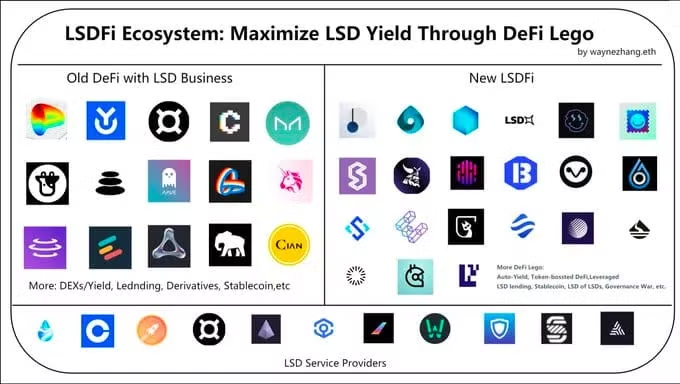
Source: An Intro to LSTfi - Shoal Research
2.1.2 Low Barrier to Liquid Staking
Ethereum's PoS implementation initially presented significant hurdles for native staking. Without delegation mechanisms, prospective stakers faced two main challenges: a high capital requirement of at least 32 ETH and the need to manage their own infrastructure. These combined barriers effectively excluded most ETH holders from participating in direct staking.
Liquid Staking, particularly Lido's model, offered a solution by dramatically lowering the entry threshold. Users could stake with as little as 0.01 ETH, opening up staking opportunities to a much broader segment of the market. This structure allowed many to participate in staking for the first time.
In contrast, native staking in the Interchain ecosystem is considerably more accessible. Thanks to built-in delegation features and user-friendly interfaces, the process is much simpler for the average user. In the next section, let’s look into what other challenges for liquid staking are present in the cosmos ecosystem.
Liquid staking in the Cosmos ecosystem has encountered several obstacles that have impeded its widespread adoption. These challenges stem from a variety of factors, including market dynamics, user preferences, and technical complexities. Below are some of the major obstacles.
2.2.1 Market Differences - Concentration of Token
Several projects in the Cosmos ecosystem tried to copy Lido's successful liquid staking model from Ethereum. However, they couldn’t overcome key differences in the Cosmos market. Cosmos has a smaller native token supply available for borrowing, resulting in higher interest rates. For instance, 62.43% of Cosmos Hub's total supply is staked. Moreover, Cosmos users prefer airdrops and active governance participation.
The concentration of Cosmos tokens among the top 200 addresses challenges liquid staking projects aimed at retail users. This distribution calls for a more sophisticated strategy to engage large token holders who control a significant portion of the supply. Consequently, retail-focused strategies may not significantly impact or gain traction within the ecosystem.
Unlike Ethereum, where validators are viewed as interchangeable service providers, Cosmos validators are integral to the ecosystem. They are active community members with strong brands and loyal followings, often acting as the main channel for large holders to stake their tokens.
Most Cosmos liquid staking protocols failed to align with validators' business objectives, missing the opportunity to leverage these valuable intermediaries to attract large holders. This oversight put them at a competitive disadvantage, as they struggled to compete effectively with the native staking options promoted by validators.
2.2.2 Lack of Compelling DeFi Use Cases
The Cosmos ecosystem has struggled to offer a wide range of appealing DeFi applications. Liquid staking tokens, designed to unlock capital for various DeFi protocols, have seen limited adoption due to a scarcity of attractive investment opportunities. This lack of compelling use cases has hindered the realization of increased liquidity benefits through liquid staking.
It's crucial to understand why DeFi is less prevalent in Cosmos. The ecosystem developed PoS before DeFi, resulting in DeFi protocols having to compete with unsustainably high staking APRs. Consequently, most users and capital gravitated towards native staking, perceiving it as more profitable and less risky than participating in the DeFi ecosystem.
Projects like Drop protocol deployed on Neutron are changing this landscape by bootstrapping a robust DeFi ecosystem where dAssets and other LSTs can be utilized.
2.2.3 Ecosystem Fragmentation and Technical Complexity
The Cosmos ecosystem emphasizes interoperability and sovereign chains, which complicates the implementation of a one-size-fits-all liquid staking solution. The IBC protocol and customizable staking mechanisms of individual chains create a fragmented landscape that poses challenges for liquid staking providers. This complexity can deter both providers and users from fully embracing liquid staking solutions. Also, to streamline inter-blockchain staking, ICA (Interchain Account) should be allowed as a host chain, but not all have enabled this feature.
2.2.4 Security Concerns
Security concerns related to liquid staking have also contributed to user hesitancy. The introduction of liquid staking features that allow the deposit of staked ATOM to obtain liquid staking tokens has introduced vulnerabilities not present in the original staking model.
Stride, a leading liquid staking provider in the Cosmos ecosystem, recently encountered issues affecting users' ability to withdraw tokens, likely due to complications from a chain upgrade. Following the Gaia v17 software upgrade on the Cosmos Hub, which introduced new features and changes, users reported difficulties in withdrawing tokens and receiving staking rewards. This upgrade, while aimed at enhancing network capabilities, may have inadvertently introduced bugs disrupting normal operations.
Drop Protocol aims to overcome the challenges of liquid staking in the Cosmos ecosystem by leveraging its unique strengths.
First, the protocol is powered by a strong team with experience and member with the Lido Alliance, which helps in promoting the adoption of liquid staking. Second, its implementation on Neutron offers distinct benefits for cross-chain operations and DeFi applications. Finally, the well-designed incentive structure aligns the interests of users, validators, and custodians, encouraging collaboration and active participation. Let’s look into these strengths in more detail.
The Drop Protocol is leveraging its strong team and strategic alliances to reshape the staking landscape. With figures such as Mitya, who previously served as Chief Product Officer at P2P, and Kai, the architect behind Lido on Terra, the team is well-equipped in terms of technical and business perspective to engage large stakeholders. Their expertise and network are instrumental in integrating Drop with leading custodians and P2P's staking platform.
Furthermore, Drop is the first member of “Lido Alliance” which could be a strategic move to bolster its position in the market. By aligning with Lido, a leader in liquid staking, Drop can tap into a broader network and leverage Lido's established network in Ethereum. This partnership is expected to facilitate the distribution and integration of wstETH, a widely used staking token, across various platforms, especially in Cosmos Ecosystem.

Source: Lido Liquid Staking
Drop is deployed as a dapp in the so called integrated application network, Neutron. Neutron has its infrastructure focused on providing the best experience to the dapps and users. It has an enshrined features and modules integrated into the Neutron blockchain, which enhance the capabilities of smart contracts based dapps.
These features, termed "enshrined components," include the CRON module for automating critical tasks, the Duality hybrid exchange for advanced trading functionalities, the Block SDK for customizing blockspace and validation mechanisms, and the Oracle Module - Slinky for reliable and timely data feeds.
Additionally, Neutron's architecture incorporates Interchain Transactions (ICTX) and Interchain Queries (ICQ) to facilitate efficient and secure cross-chain interactions, further enhancing the operational capabilities of dapps on the platform. With these features, Drop Protocol is acheiving cross-chain operation of liquid staking in other blockchains.
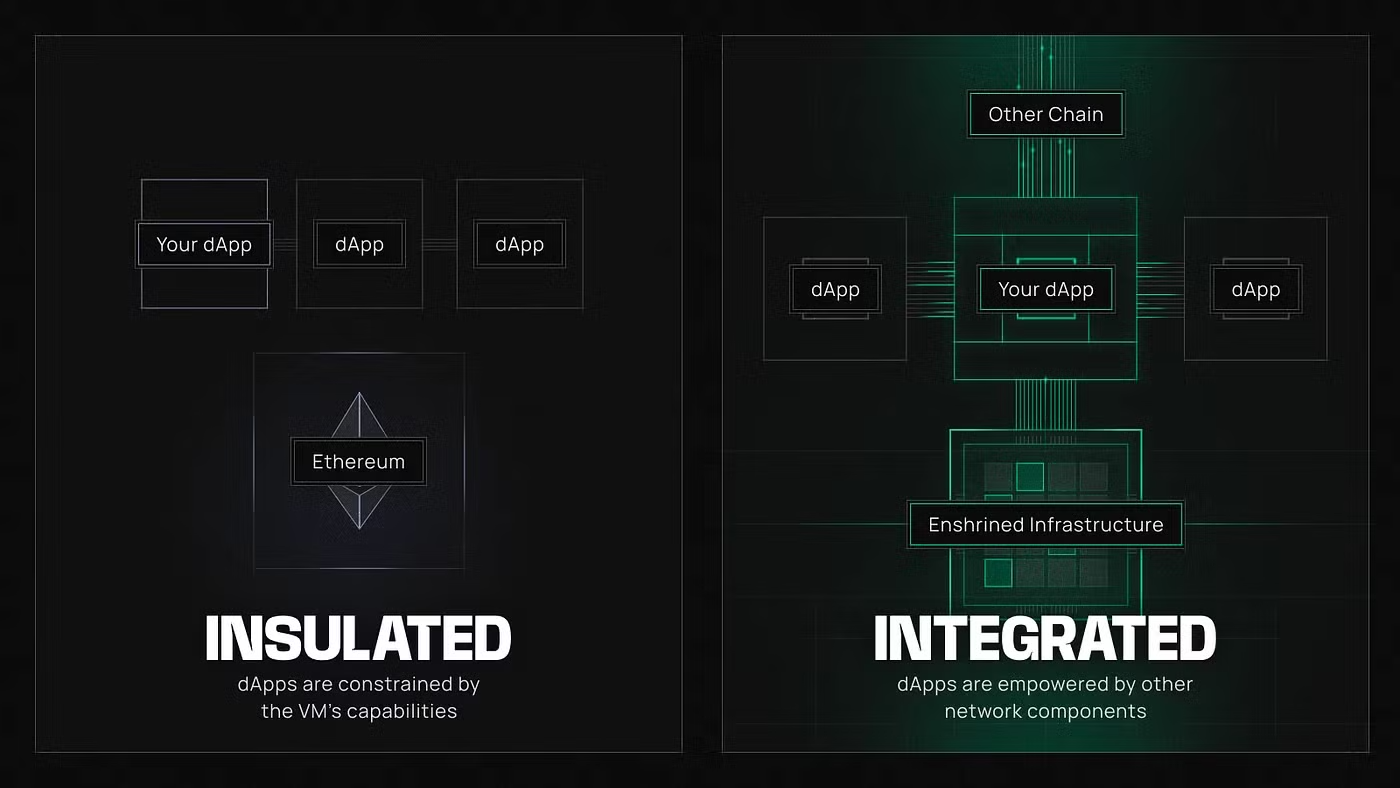
Source: Neutron : The Integrated Application Network | by Neutron.org | Medium
Beyond infrastructure, Drop Protocol is integrated into various applications to utilize its liquid staked assets (dAssets) in the DeFi ecosystem. These applications include Apollo vaults for secure digital asset management and Fission yt/pt tokens for yield tokenization and trading, similar to Pendle. Astroport PCL pools provide liquidity services, enhancing the trading experience.
Projects like Mars offer lending, borrowing, and margin trading, expanding financial opportunities for users. Levana introduces dAsset collateral options for perpetual contracts, adding more financial instruments. Amulet offers self-repaying loans, helping users manage their debt efficiently. Together, these elements create a strong and dynamic DeFi environment, providing the use cases for the dAssets.
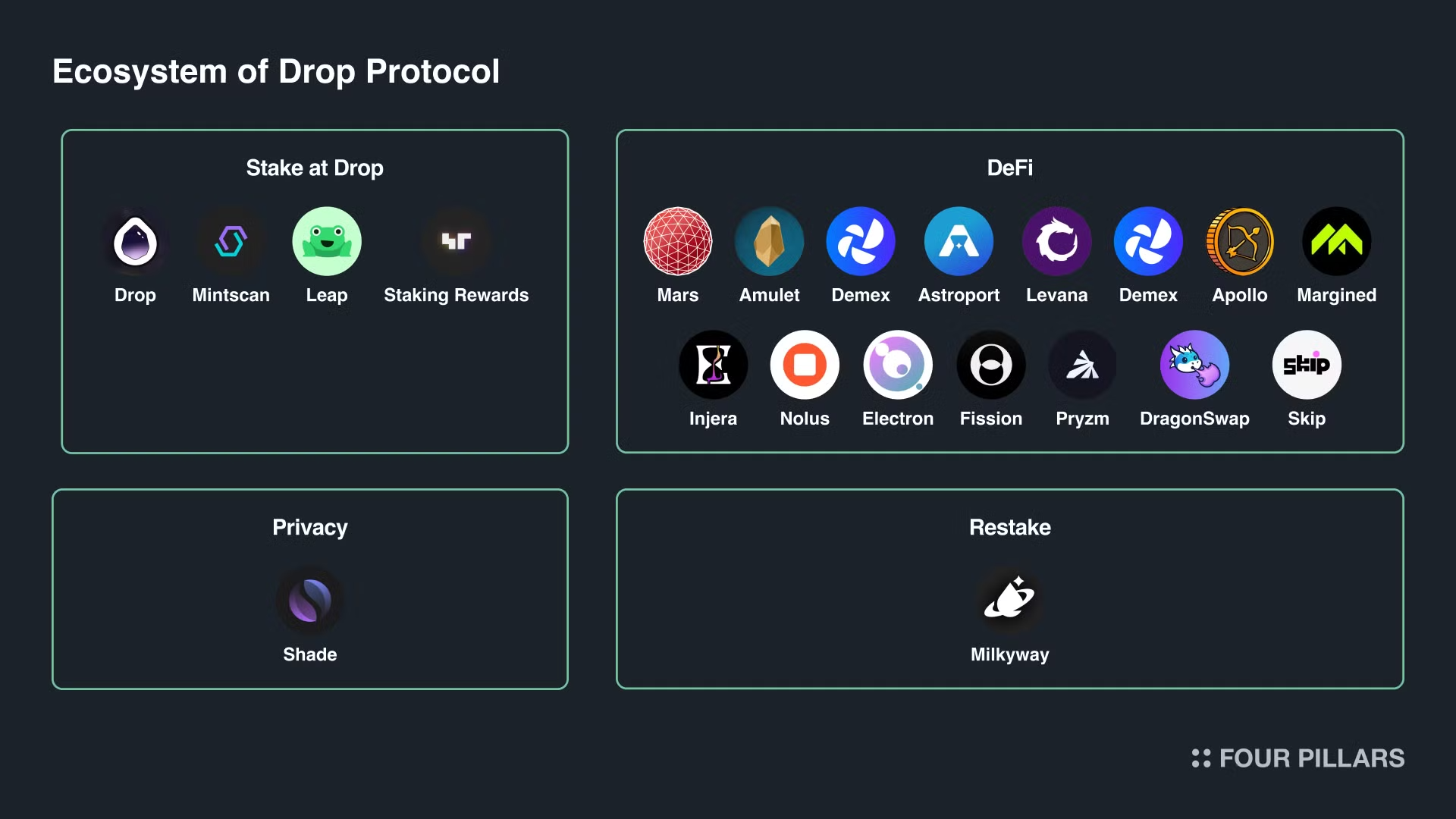
Incentive alignment is crucial for the success of any ecosystem liquid staking project, and Drop is no exception. By strategically aligning the interests of all participants, from users to validators, Drop aims to create a mutually beneficial environment. This not only encourages active participation but also strengthens the overall network. From Validators, Custodians and Users. Here's how Drop achieves this:
Validators play crucial roles in the Drop protocol. They secure networks like Cosmos Hub and Celestia while also acting as referral agents for Drop staking. Validators earn rewards through commissions on referred stakes and revenue sharing from staking activities. This dual incentive structure motivates them to promote Drop actively, using their connections with major holders and stakers to influence stake allocation. Their strong network within the staking community makes validators instrumental in driving the adoption of liquid staking.
Channel Partners, including wallets and custodians, are integral to the Drop protocol's distribution strategy. Their main activities involve promoting the protocol and participating in referral campaigns. Channel partners are rewarded through these campaigns by earning incentives for bringing new users to the platform. Additionally, they benefit from revenue sharing on general channel partnerships. This includes collaborations with well-known wallets like Keplr, Leap, and Cosmostation, as well as custodians. These partnerships enable channel partners to share in the upside of their referrals and contribute to the protocol's growth.
Users also get a comprehensive set of benefits through Staking with Drop protocol . Users earn autocompounding native staking rewards from their staked assets, such as ATOM rewards for staking dATOM. Additionally, they can leverage their dASSETs in DeFi activities to potentially earn trading fees, lending rates, and other incentives in Neutron and beyond. The Droplets program provides an extra layer of rewards, offering additional APR on top of native staking rewards, which can be amplified through DeFi participation. Users also become eligible for airdrops from projects that include liquid staking providers in their distribution. To further encourage engagement, the Droplets Program implements a point system divided into Epochs, rewarding users for various activities within the Drop protocol ecosystem.
The Drop Protocol is a liquid staking solution designed for the Cosmos blockchain ecosystem. It is implemented using CosmWasm and deployed on the Neutron network, aiming to manage staking operations across different blockchain networks through smart contracts and interchain accounts.
The protocol is designed to operate in a decentralized manner, with permissionless handlers ensuring that no centralized party is required for its long-term operation.
The Drop Protocol's architecture features two main smart contract modules managed by the Drop Protocol DAO. The DAO oversees the protocol's administration, validator management, and emergency handling. The two primary modules are:
Factory Module: Creates and manages protocol instances, handling upgrades and administration.
Instance Module: Operates liquid staking for a specific blockchain network independently, without interacting with other instances.

The Drop Protocol operates through separate instances, each dedicated to a specific blockchain (like Cosmos Hub, Celestia, or Osmosis) and its associated token (such as ATOM, TIA, or OSMO). These instances are comprised of smart contracts and components that collaboratively manage staking operations. It's important to note that the protocol can handle networks with multiple reward types. For example, Cosmos Hub stakers might receive ATOM, NTRN, STRD, and other tokens as rewards. In such cases, all rewards are converted to the primary token (ATOM) and automatically reinvested. Key components of these instances include:
4.2.1 Core Operation Management
Core Contract: Acts as the central point of interaction for users, handling deposits and withdrawals. It manages the staking operations on the remote blockchain via IBC transactions and calculates the exchange rate for dTokens, the liquid staking derivative tokens issued by the protocol.
Token Contract: Utilizes the token factory module to mint and burn dTokens. This contract is tightly integrated with the core contract to ensure secure and efficient token operations within the protocol.
Strategy Module: This module is responsible for efficiently distributing stakes among a set of validators. It ensures optimal performance and security of the protocol by managing the validator set and can provide different staking strategies, such as conservative or aggressive allocations.
Withdrawal Manager: Facilitates the process of unbonding and withdrawal. It ensures that users can efficiently withdraw their staked assets after the unbonding period, utilizing NFTs to track and manage pending withdrawals. One unique thing about this NFT is that it can be traded, which could open up a secondary marketpalce for staking or fast unbounding solutions.
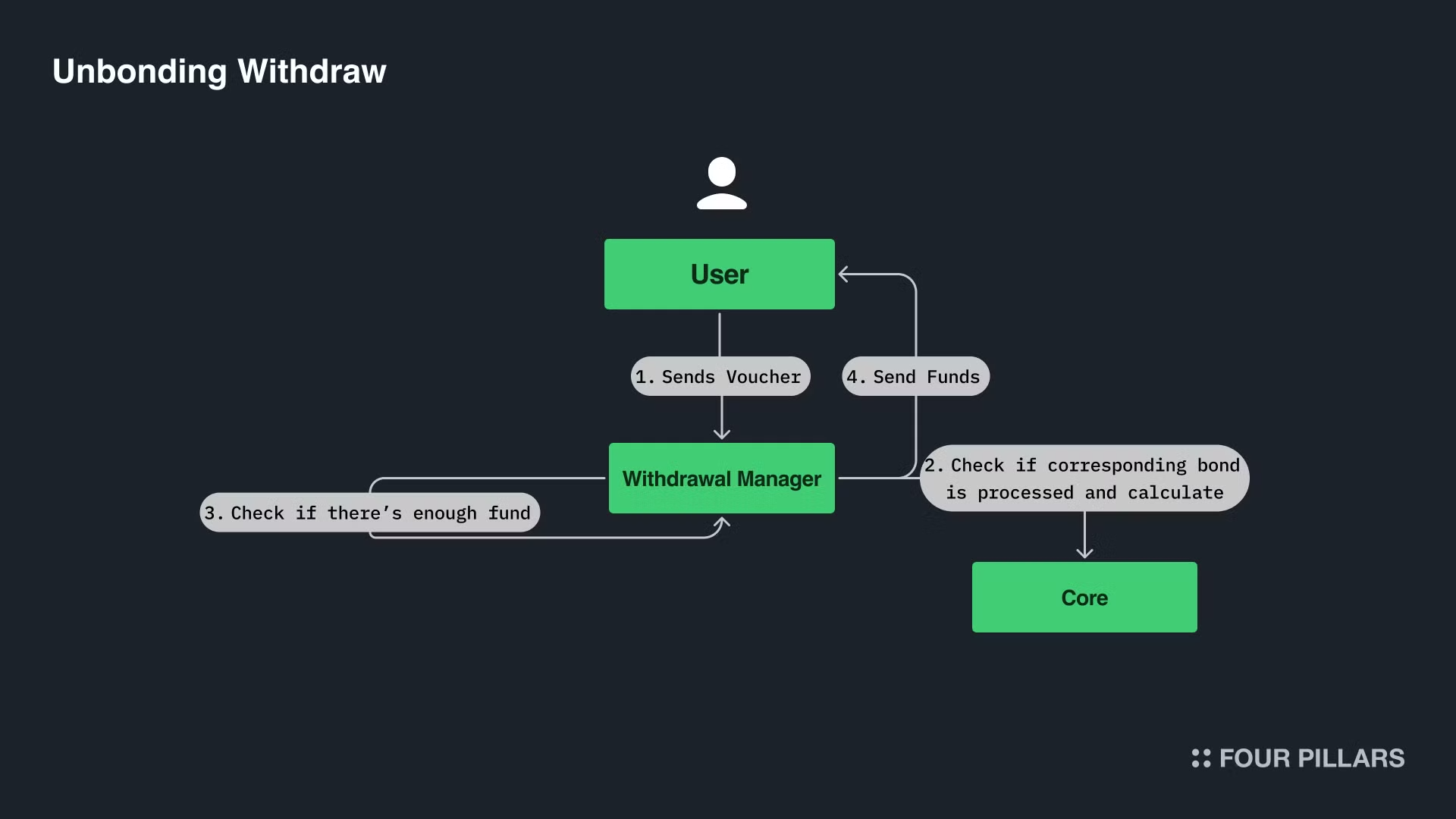
4.2.2 Interchain Management
Puppeteer Contract: Interacts with remote chains via IBC to execute staking-related requests, manage balances, and ensure that transactions are conducted accurately and in a timely manner. It serves as an intermediary between high-level protocol instructions and low-level interchain transactions.
ICQ Relayer: The Interchain Query (ICQ) relayer is designed to synchronize actions with the state of the blockchain. Unlike traditional relayers that work automatically, the ICQ relayer in Drop Protocol is condition-based, allowing off-chain components to manually submit ICQ results before calling contracts. This ensures that the protocol's operations are aligned with the most current blockchain data, particularly during staking and undelegation transactions.
The Cosmos ecosystem faces challenges with inefficient token lockup due to staking and limited use cases for the token.
This issue is evident in chains like Cosmos Hub, where 62.6% of tokens are staked and 2% are in liquid staking, and Celestia, with 72.7% staked and 3.56% in liquid staking. While staked tokens provide blockchain security, this approach is capital-inefficient and unsustainable. The lack of token utility exacerbates this problem. For instance, Cosmos Hub does not have dapps, with only ICS (where validators build blocks for other blockchains like Neutron and Stride) serving as a use case.
Neutron and Drop Protocol have positioned to address these issues. Neutron's infrastructure focuses on optimizing DeFi experiences, featuring embedded oracles, interchain infrastructure via IBC, and automated operations through Cron modules. With multiple dapps offering use cases for liquid staking tokens from day one, Drop Protocol's LSTs could find immediate use cases. Drop Protocol's team brings valuable experience from building Lido on Terra and benefits from institutional connections through being a member of Lido Alliance.
However, Cosmos has struggled to adopt LSTs successfully in the past. This suggests persistent difficulties in onboarding top token holders, as tokens are concentrated among a few major holders.
Can Drop Protocol attract these key holders? Will Neutron provide compelling use cases for potential LST holders? While these teams have plans to tackle these challenges, it's crucial to monitor how their strategies unfold in this early stage.
Liquid staking is especially interesting in the Cosmos ecosystem as it has seen a variety of approaches and outcomes. One notable early attempt was Anchor Protocol's bAsset, which, despite its eventual failure, provided valuable insights and lessons for future projects. Let’s look into some of the major developments of liquid staking in the Cosmos ecosystem in a chronological order.
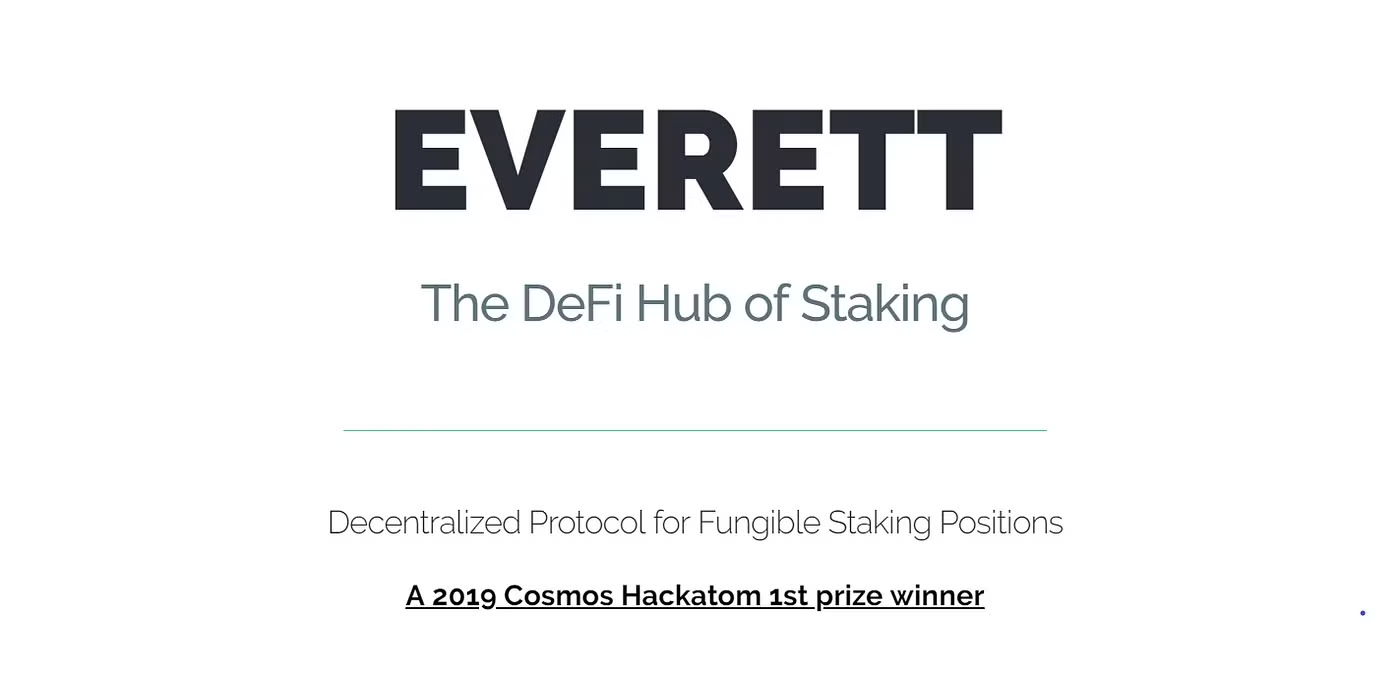
Source: Introducing Everett. The DeFi Hub of Staking | by Ryan Park
The Everett Protocol was designed to address economic inefficiencies in Proof of Stake (PoS) blockchain systems. One of its primary goals was to counter the disincentivization of ecosystem development caused by high staking rewards. In traditional PoS models, token holders were often motivated to stake their tokens to earn rewards rather than invest in DeFi or provide liquidity, which typically offered lower returns. This created an ecosystem where beneficial applications were underutilized, stifling innovation and utility. The Everett Protocol introduced a secondary, fungible "shadow token" pegged to staked tokens, allowing stakeholders to earn rewards while simultaneously using their shadow tokens within the ecosystem. This innovation sought to balance security and active participation in dApp development. This project was later acquired by Terraform Labs, becoming the initial version of Anchor.
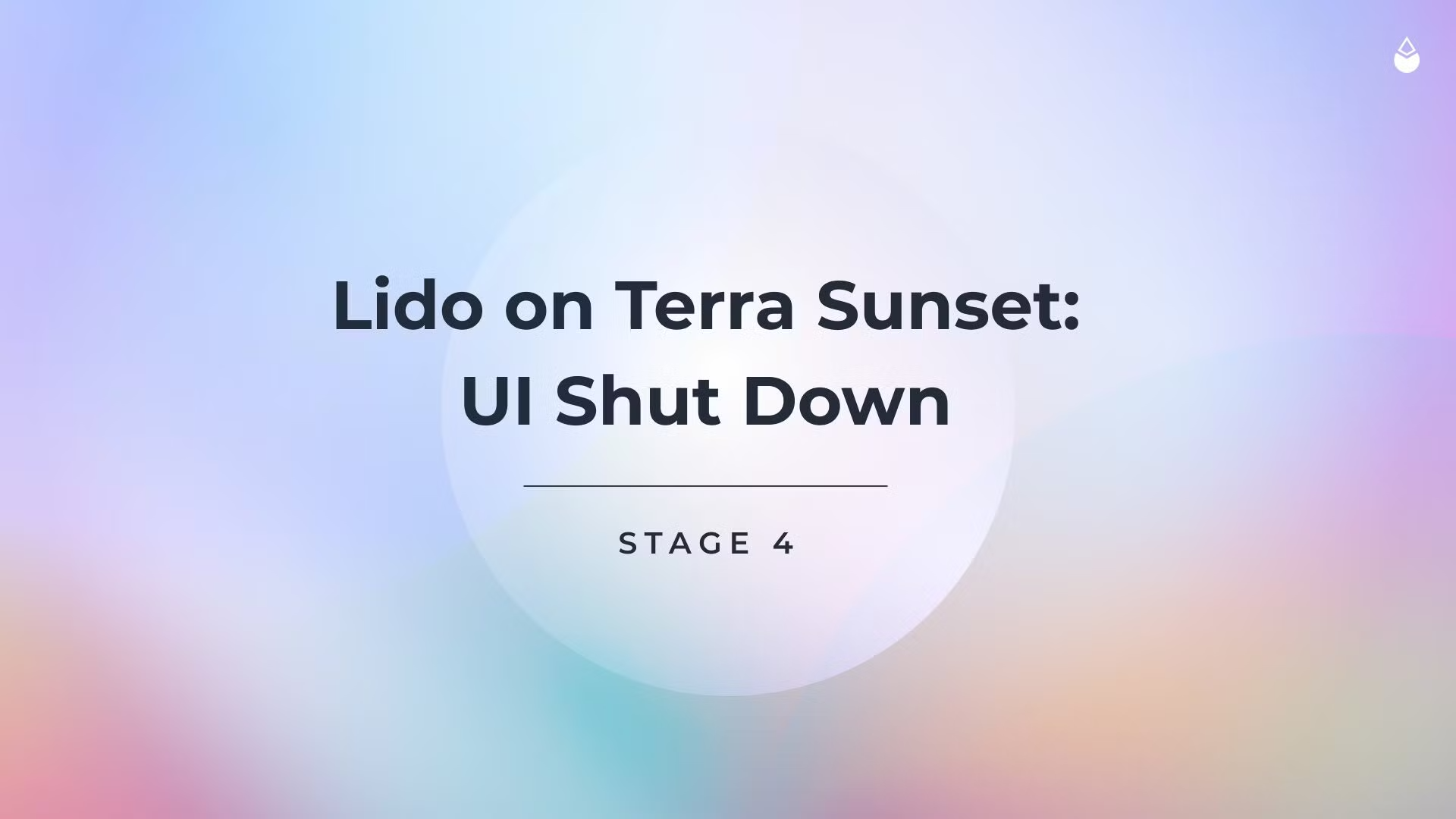
Lido played a crucial role in the Terra ecosystem by enabling users to stake their LUNA tokens through a protocol called "Lido on Terra." At its peak, it had a Total Value Locked (TVL) of around $10 billion. This was accomplished by issuing liquid staking derivatives, such as bLUNA, which represented staked LUNA. These derivatives allowed users to engage in DeFi activities while still earning staking rewards, effectively making these tokens usable across the broader Terra DeFi ecosystem.
A notable example was Anchor Protocol, a decentralized savings platform on the Terra blockchain. It used these liquid staking derivatives in its Money Market, accepting bAssets (like bLUNA) as collateral. This allowed users to earn stable yields on their deposits. Anchor's design aimed to stabilize yields around a target "Anchor Rate," using the staking rewards from these bAssets to offer competitive and consistent returns to depositors.
Despite their innovative approaches, both Lido and Anchor were impacted by the collapse of the Terra ecosystem. The de-pegging of Terra's stablecoin, UST, triggered a series of failures that ultimately led to Anchor Protocol's downfall. (Check out this article on Lido on Terra team’s journey after the collapse.)
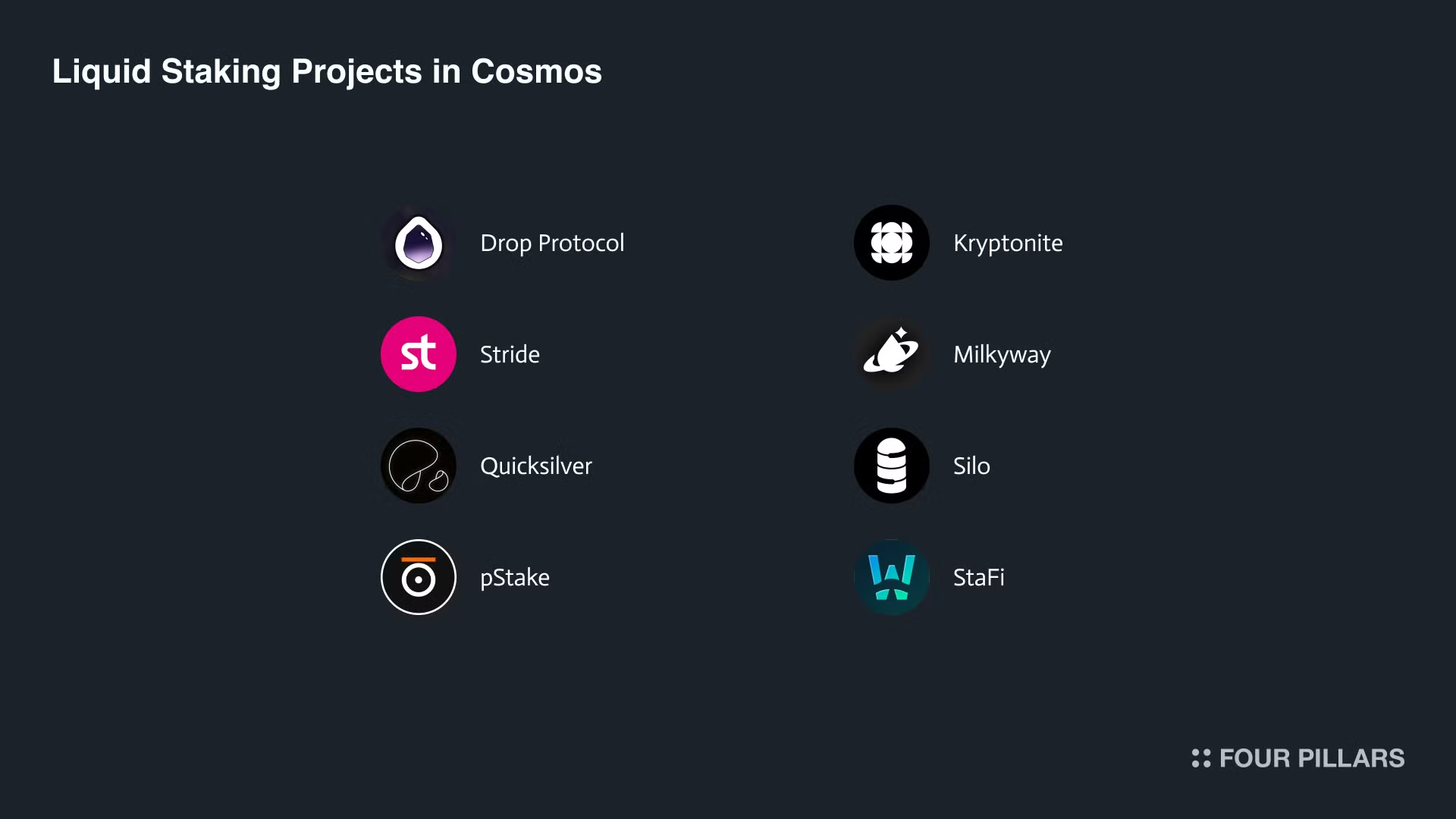
After the collapse of Terra and Anchor, liquid staking started to get actively developed in other Cosmos-based blockchains. Leading projects in this space include Stride, Quicksilver, and pStake. Stride, in particular, focused on providing liquid staking solutions across multiple Cosmos chains, allowing users to stake assets from various networks and receive liquid representations. Stride's cross-chain approach helped broaden the scope and utility of liquid staking within the Cosmos ecosystem, contributing to its rapid growth and adoption.
Also, projects like Milkyway, a liquid staking projects initally focused on Celestia, has gained market share in a short timeframe, reaching TVL of $23M. They are now being built as a rollup (Minitia L2, a rollup in Initia) in the Initia ecosystem. (Check out this article on Initia by Four Pillars)
In September 2023, Cosmos Hub introduced an upgrade known as "Gaia v12," which included the integration of a native Liquid Staking Module (LSM) at the network level. The LSM allows for the direct liquid staking of ATOM without the traditional 21-day unbonding period, thereby enabling over $1 billion worth of staked ATOM to be deployed across various DeFi protocols. To mitigate risks, the initial implementation has been capped at 25% of all staked ATOM.
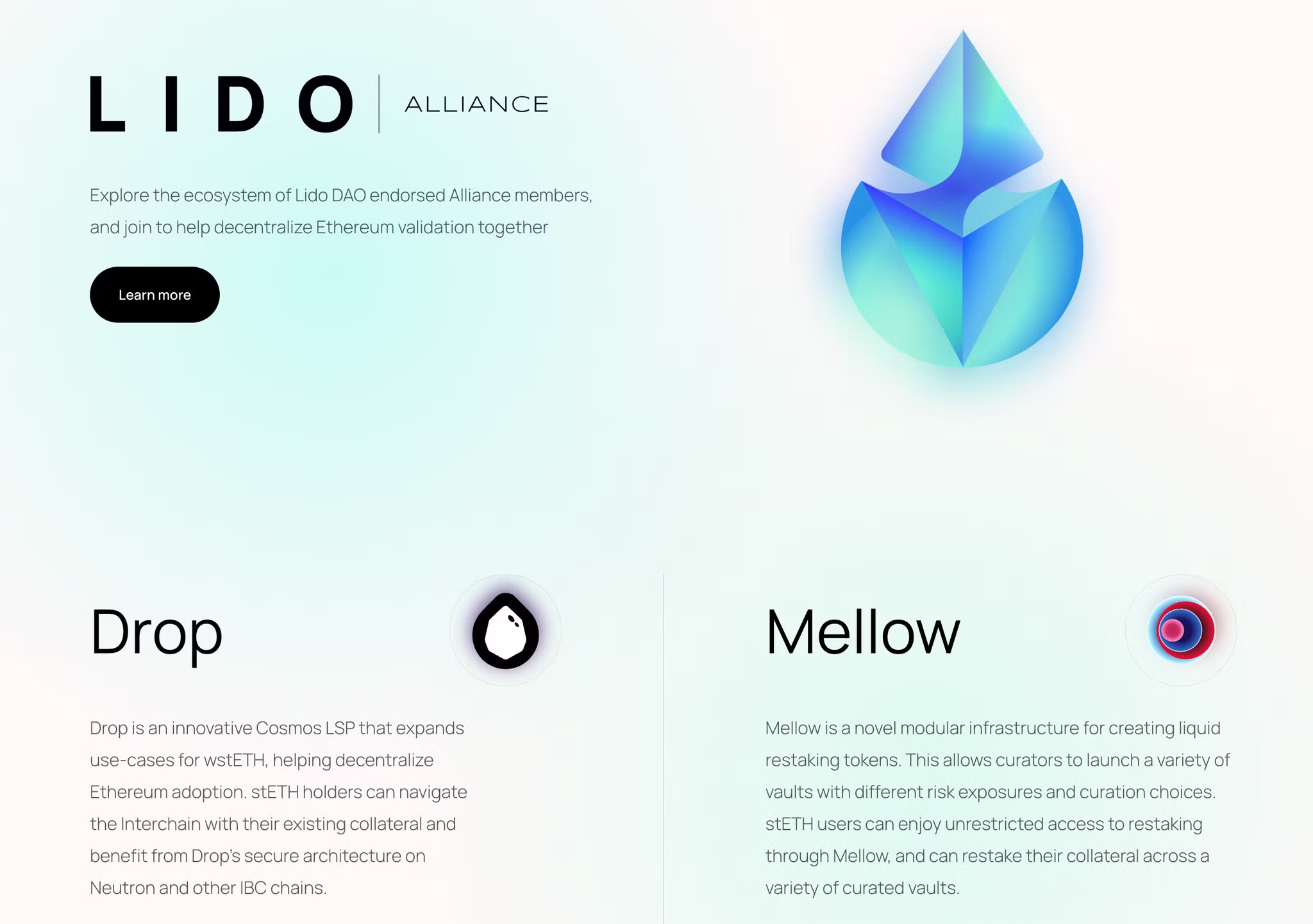
Source: Lido Liquid Staking
The Lido Alliance, an initiative aimed at promoting infrastructure development around stETH and expanding its use cases, particularly in restaking, has recently gained attention with the potential onboarding of its first onboarding project, Drop protocol. Drop protocol is a cross-chain liquid staking protocol in Neutron, designed for the Cosmos ecosystem. This collaboration between Lido and Drop represents a development in the liquid staking landscape, potentially bridging the gap between Ethereum and Cosmos ecosystems. As the integration of wstETH in the Interchain may expand, potentially increasing its use cases and liquidity within Cosmos. Additionally, Drop's involvement could make Cosmos ecosystem to adopt more on liquid staking.
Dive into 'Narratives' that will be important in the next year